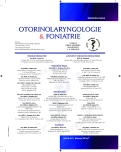The Relation between Voice Range Profile Parameters and Perceptual Evaluation of Pathological Male Voices
Authors:
M. Frič
; V. Krasňanová
Authors‘ workplace:
Výzkumné centrum hudební akustiky, Hudební a taneční fakulta Akademie múzických umění v Praze, vedoucí Ing. Z. Otčenášek, Ph. D.
Published in:
Otorinolaryngol Foniatr, 63, 2014, No. 1, pp. 16-28.
Category:
Original Article
Overview
The voice range profile (VRP) is the fundamental method for evaluation of frequency and dynamic ranges of the voice. In addition to the subjective perceptual evaluation of the voice it should belong to primary examination of the voice in phoniatry. The study investigates the relations between perceptual assessment of the voice by GRBAS scales and the parameters of speech, singing and shouting VRPs in 25 males with various grades and etiologies of their voice problems. Four subjects participated in the perceptual evaluation by visual analog scales of GRBAS features and ranking test of RB and the darkness and the width as the basic perceptual features of the sound. The results showed significant agreement in perceptual evaluation, the high correlation in GRB and moderate in AS. Factor analysis of perceptual evaluation described two main factors, the breathy and asthenic voices dominated in evaluation of the overall severity over the rough and strain voices. Speech range profile parameters showed only trend relation to perceptual assessment, positively between the pitch and strain and negatively between intensity and breathiness and asthenia. In singing and shouting VRP there were found more dominant relations. The main negative relations were among maximal intensity and GBA scales. In singing VRP there were additional important parameters as dynamic range, and VRP area, which negatively correlated with overall severity and breathiness. Next analysis revealed significant limitation of falsetto phonation in pathological voice.
Keywords:
voice range profile, perceptual evaluation, GRBAS, pathological voice
Sources
1. ASHA 3rd Division: Consensus auditory-perceptual evaluation of voice (CAPE-V)[on line]2002[cit. DATUM]. Dostupný na WWW: http://www.asha.org/NR/rdonlyres/C6E5F616-972F-445A-AA40-7936BB49FCE3/0/D3CAPEVprocedures.pdf.
2. Dejonckere, P. H., Bradley, P., Clemente, P., Cornut, G.,Crevier-Buchman, L., Friedrich, G., Van De Heyning, P., Remacle, M., Woisard, V.: A basic protocol for functional assessment of voice pathology, especially for investigating the efficacy of (phonosurgical) treatments and evaluating new assessment techniques. Guideline elaborated by the Committee on Phoniatrics of the European Laryngological Society (ELS). Eur. Arch. Otorhinolaryngol., roč. 258, 2001, č. 2, s. 77-82.
3. Frič, M., Kulhánek, T., Hrb, J.: Sytém vzdáleného přístupu k analýze hlasu RealVoiceLab, MARC-Technologický list čís. 46, Výzkumné centrum hudební akustiky HAMU, Praha, 2012.
4. Frič, M., Otčenášek, Z.: Přehled metodických postupů subjektivního popisu vlastností hlasových projevů v oblasti poruch, patologie a terapie hlasu. Otorinolaryng. a Foniat. /Prague/, roč. 59, 2010, č. 4, s. 214-224.
5. Henrich, N., Doval, B., Castellengo, M.: On the use of electroglottography for characterisation of the laryngeal mechanisms. Proceedings of the Stockholm Music Acoustics Conference, August 6-9, 2003 (SMAC 03), Stockholm, SwedenON, roč. 2003, s. 455-458.
6. Hirano, M.: Psychoacoustic evaluation of voice: GRBAS scale for evaluating the hoarse voice. Vienna Springer, Vienna, 1981.
7. Karnell, M. P., Melton, S. D., Childes, J. M., Coleman, T. C., Dailey, S. A., Hoffman, H. T.: Reliability of clinician-based (GRBAS and CAPE-V) and patient-based (V-RQOL and IPVI) documentation of voice disorders. J. Voice, roč. 21, 2007, č. 5, s. 576-590.
8. Kelchner, L. N., Brehm, S. B., Weinrich, B., Middendorf, J., deAlarcon, A., Levin, L., Elluru, R.: Perceptual evaluation of severe pediatric voice disorders: rater reliability using the consensus auditory perceptual evaluation of voice. J. Voice, roč. 24, 2010, č. 4, s. 441-449.
9. Leinonen, L., Hiltunen, T., Laakso, M. L., Rihkanen, H., Poppius, H.: Categorization of voice disorders with six perceptual dimensions. Folia Phoniatr. Logop., roč. 49, 1997, č. 1, s. 9-20.
10. Li, N. Y. K., Yiu, E. M.: Acoustic and perceptual analysis of modal and falsetto registers in females with dysphonia. Clinical Linguistics & Phonetics, roč. 20, 2006, č. 6, s. 463-481.
11. Schneider, B., Bigenzahn, W.: Influence of glottal closure configuration on vocal efficacy in young normal-speaking women. J. Voice, roč. 17, 2003, č. 4, s. 468-480.
12. Schneider, B., Bigenzahn, W.: How we do it: voice therapy to improve vocal constitution and endurance in female student teachers. Clin. Otolaryngol., roč. 30, 2005, č. 1, s. 66-71.
13. Schneider-Stickler, B., Knell, C., Aichstill, B., Jocher, W.: Biofeedback on voice use in call center agents in order to prevent occupational voice disorders. J. Voice, roč. 26, 2012, č. 1, s. 51-62.
14. Štěpánek, J., Moravec, O.: Percepční prostory barvy hudebního zvuku a jejich slovní popis. Závěrečná zpráva GA ČR 202/02/1370, Hudební fakulta Akademie múzických umění v Praze, 2004.
15. Wuyts, F. L., Boldt, M. S., Molenberghs, M., Remacle, M., Heylen, L., Millet, B., Lierde, K., Raes, J., Heyning, P. H.: The dysphonia severity index: an objective measure of vocal quality based on multiparameter approach. J. Speech Hear. Res., roč. 43, 2000, s. 796-809.
16. Wuyts, F. L., Heylen, L., Mertens, F., Du Caju, M.,Rooman, R., Van de Heyning, P. H., De, Bodt, M.: Effects of age, sex, and disorder on voice range profile characteristics of 230 children. Ann. Otol. Rhinol. Laryngol., roč. 112, 2003, č. 6, s.540-548.
17. Yamaguchi, H., Shrivastav, R., Andrews, M. L., Niimi, S.: A comparison of voice quality ratings made by Japanese and American listeners using the GRBAS scale. Folia Phoniatr. Logop., roč. 55, 2003, č. 3, s. 147-157.
Labels
Audiology Paediatric ENT ENT (Otorhinolaryngology)Article was published in
Otorhinolaryngology and Phoniatrics

2014 Issue 1
Most read in this issue
- Bleeding of Post-Tonsillectomy
- Obstructive Sleep Apnea Syndrome - Effectivity of Different Surgical Approaches
- Atypical form of Meniere’s Disease
- The Spread of Infection through the Danger Zone in to the Mediastinum
